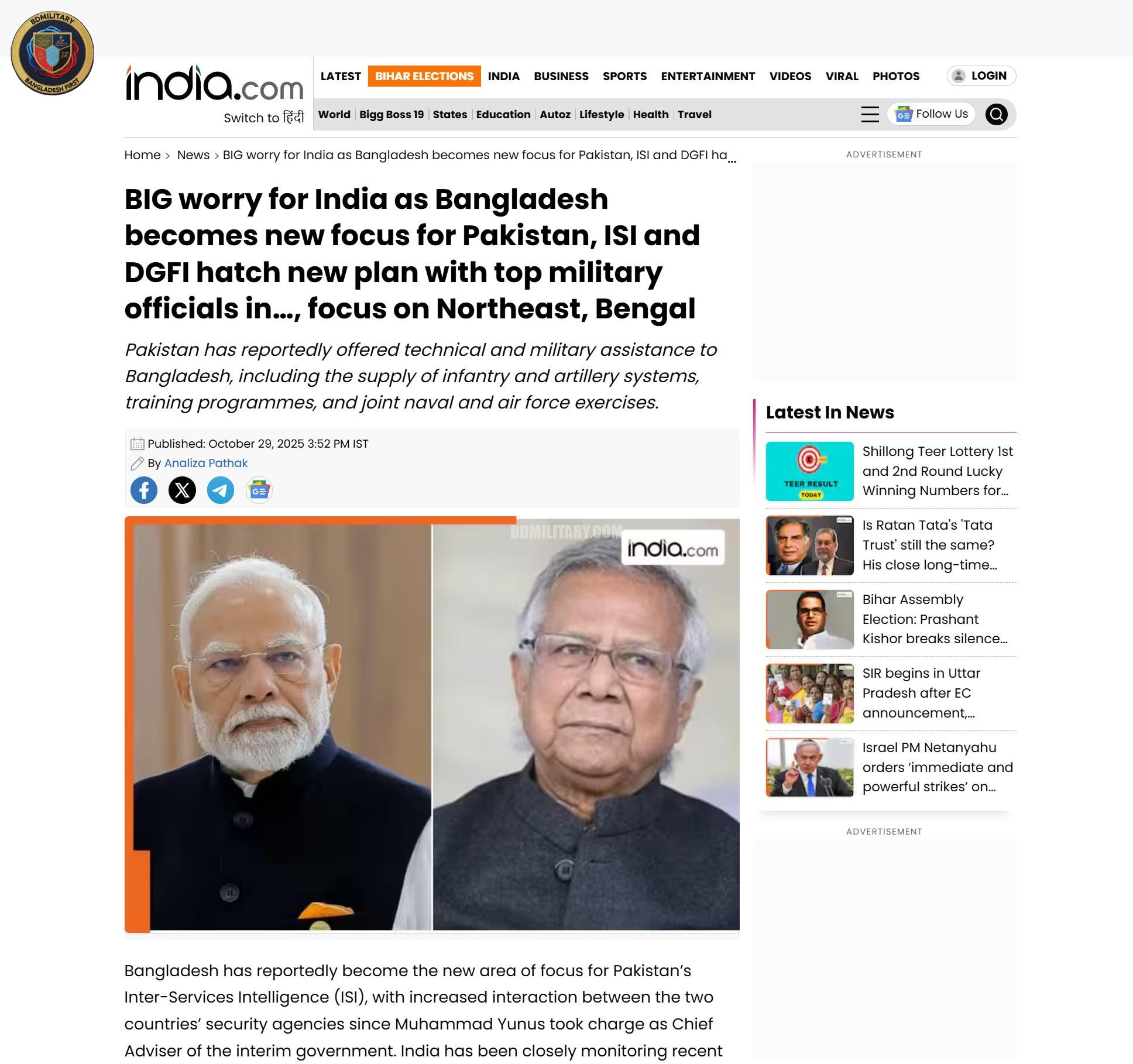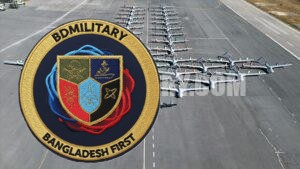Recent Indian media reports have portrayed a dramatic deepening of military and intelligence ties between Bangladesh and Pakistan, with alarmist headlines warning of “panic in India” and “new ISI–DGFI cooperation cells” operating in Dhaka.
The BDMilitary Information Warfare Desk conducted a verification review to separate confirmed developments from speculative or unsubstantiated claims.
What Actually Happened: Confirmed Developments
Between 26–29 October 2025, Pakistan’s Chairman of the Joint Chiefs of Staff Committee (CJCSC), General Sahir Shamshad Mirza, undertook an official four-day visit to Dhaka.
During his stay, he met with Chief Adviser Professor Muhammad Yunus, Lieutenant General S.M. Kamrul Hassan, Chief of Army Staff General Waker-Uz-Zaman, and senior leadership of the Bangladesh Navy and Bangladesh Air Force.
The visit was covered by multiple Bangladeshi and Pakistani outlets, including The Daily Star, bdnews24, Dhaka Tribune, Radio Pakistan and ISPR statements.
Both sides described the talks as “cordial” and “focused on expanding cooperation in trade, defence, and regional stability.”
General Mirza’s delegation also held courtesy calls with senior service chiefs and visited several military establishments in Dhaka.
The delegation stayed at the Radisson Blu Water Garden Hotel, operated by the Bangladesh Army Welfare Trust, underscoring the formal hospitality accorded to the visit.
So far, this is the only officially confirmed portion of the story.
The Allegations: What the Indian Media Claimed
Several Indian outlets — most prominently the article published by Analiza Pathak on 29 October — asserted that:
- An ISI officer was part of the Pakistani delegation to Dhaka.
- A Joint Intelligence Mechanism (JIM) has been created between Pakistan’s Inter-Services Intelligence (ISI) and Bangladesh’s Directorate General of Forces Intelligence (DGFI).
- A dedicated ISI cell is being established inside the Pakistan High Commission in Dhaka.
- Pakistan has offered infantry and artillery systems, Fatah-series rocket systems, and JF-17 fighter jets to Bangladesh.
- A follow-up Pakistani delegation will return to Dhaka next month to sign defence agreements.
- The new partnership is part of an ISI–DGFI plan focusing on India’s Northeast and West Bengal.
Verification Findings
BDMilitary cross-checked these claims through open-source intelligence (OSINT) and official statements from Dhaka, Islamabad, and reputable non-Indian sources.
| Claim | Verification Status | Findings |
|---|---|---|
| ISI officer in Mirza’s delegation | ❌ Unverified | No official or independent Bangladeshi/Pakistani media mention any ISI presence. Delegation lists published by Pakistani state media name only senior military and defence officials. |
| Creation of ISI–DGFI “Joint Intelligence Mechanism” | ❌ Unverified | No announcement or MOU confirmed. DGFI and ISPR have made no reference to an intelligence-sharing framework. |
| ISI cell inside Pakistan High Commission, Dhaka | ❌ Unverified | No confirmation from Bangladesh Ministry of Foreign Affairs or Pakistan High Commission. This claim originates solely from Indian sources. |
| Pakistan offering artillery, rockets, and JF-17s | ⚠️ Partially Plausible | Pakistan has long sought to market the JF-17 to Bangladesh; exploratory discussions date back to 2018–2020. No signed procurement deals are recorded. |
| Pakistani follow-up delegation to sign defence deals | ❌ Unverified | No visit or signing event scheduled in official calendars as of 30 October 2025. |
| ISI–DGFI focus on Northeast India | ⚠️ Speculative | While regional intelligence monitoring is plausible, no evidence confirms a coordinated ISI–DGFI plan. |
Context and Analysis
Relations between Dhaka and Islamabad have visibly thawed in recent months following the end of the Sheikh Hasina administration.
Bangladesh’s interim government under Professor Muhammad Yunus has pursued an open foreign policy — engaging with a wide array of partners, including Pakistan, Türkiye, China, the UK, and the US.
Pakistan, for its part, is seeking to revitalise historical ties that had cooled for decades.
Islamabad’s focus is pragmatic: potential defence exports, training programmes, and academic exchanges.
Bangladesh remains interested in affordable air and artillery systems, but sources in Dhaka stress that no agreements have yet been signed with Pakistan.
In contrast, the Indian media’s framing — portraying Bangladesh as an emerging “frontline” for ISI operations — reflects Delhi’s strategic anxiety rather than documented policy changes.
Since India views any intelligence or defence convergence between Dhaka and Islamabad through a security lens, the narrative of “panic” serves domestic audiences more than it reflects facts on the ground.
Information Warfare Assessment
The article published by Analiza Pathak fits the pattern of narrative amplification often used in regional information operations:
- Kernel of truth: a verified high-level visit.
- Layer of speculation: unverified intelligence and military claims.
- Emotive framing: “panic”, “cell”, “plan against India” — aimed at influencing public perception and policymaking.
Such reporting blurs the line between intelligence commentary and psychological influence, leveraging national sensitivities to create distrust and alarm.
Concluding Remarks
The only confirmed event is the high-level CJCSC visit and discussions on future cooperation.
All other claims — including intelligence-sharing, ISI cells, and signed defence agreements — remain unsubstantiated.
No Bangladeshi or Pakistani authority has validated these assertions, nor have international outlets such as Reuters, AFP, or BBC reported them.
Until concrete evidence emerges, these claims should be treated as part of a media-driven influence narrative, not as verified operational reality.
BDMilitary Information Warfare Verdict
| Category | Verdict |
|---|---|
| Claim: “ISI–DGFI joint intelligence mechanism established.” | ❌ False / Unverified |
| Claim: “Bangladesh to buy JF-17s and Fatah-series rockets next month.” | ⚠️ Unconfirmed speculation |
| Claim: “ISI cell operating inside Pakistan High Commission, Dhaka.” | ❌ Unsupported allegation |
| Claim: “Pakistan–Bangladesh military cooperation increasing.” | ✅ True — but still limited to diplomatic and exploratory levels |
Annex A: Examples of Indian Media Framing
Examples of Indian media framing.
| Outlet | Quote (verbatim) | Tone / Analysis |
|---|---|---|
| India.com (30 Oct 2025) | “Potential threat to India: Pakistan Army’s top general to visit … the Siliguri corridor.” | Frames routine diplomatic visit as an immediate threat to India’s strategic ‘chicken-neck’. |
| The Telegraph (India) (27 Aug 2025) | “Growing Pakistani influence there poses security risks that India cannot ignore.” | Editorialises a bilateral thaw as a direct security risk. |
| Outlook India (25 Jan 2025) | “India will keep a close watch on developments in Bangladesh as Pakistani intelligence and military officials are visiting them.” | Portrays standard monitoring as emergency vigilance. |
| Hindustan Times (2025) | “Red flags in Delhi as a 4-member ISI team from Pak makes a quiet visit.” | Conflates regular delegation movement with covert intent. |
| NDTV (2025) | “Pakistan’s notorious spy agency ISI secretly sent four top members to Dhaka, raising a red flag in New Delhi.” | Uses emotive adjectives (“notorious”, “secretly”) to dramatise. |
| Times of India (2025) | “Both countries will support each other.” | Basic diplomatic phrasing spun as strategic alignment. |
| Firstpost (2025) | “Should India be concerned?” | Poses rhetorical anxiety as news framing. |
| Navbharat Times (Hindi, 2025) | “Pakistan Army stirs up activity in Bangladesh … this could open a Bangladesh front against India.” | Explicitly suggests a new military front; alarmist tone. |
Final Assessment
Bangladesh–Pakistan defence engagement is indeed expanding — but through formal diplomacy, not covert intelligence pacts.
The Indian media narrative exaggerates the extent of this cooperation to project a security threat to India’s northeast.
Until proven otherwise, the story is best categorised as information warfare through perception shaping, rather than credible strategic intelligence.
Sources:
- bdnews24.com, The Daily Star, Dhaka Tribune (Dhaka)
- Radio Pakistan, ISPR Pakistan
- India.com, The Telegraph India, Outlook India, Hindustan Times, NDTV, Times of India, Firstpost, Navbharat Times
- BDMilitary independent verification and OSINT review

Khaled Ahmed is a seasoned former intelligence analyst and military expert from the Netherlands, bringing over 15 years of specialised experience in operational intelligence, threat analysis, and strategic defence planning. Having served in high-level, classified roles within Dutch military intelligence, he possesses rare expertise in European security architecture, NATO doctrine, and asymmetric warfare. Khaled’s deep operational insight and international perspective enable him to deliver precision-driven intelligence analysis and forward-looking strategic forecasts. A trusted contributor to high-level risk assessments and security briefings, he offers readers clarity on complex defence and security challenges. Khaled leads the National Security and Fact Analysis sections at BDMilitary. He holds a Master’s degree in International Relations from the University of Groningen, The Netherlands, and is fluent in Dutch, French, and Arabic — combining linguistic dexterity with operational expertise to analyse security issues across cultures and regions.

